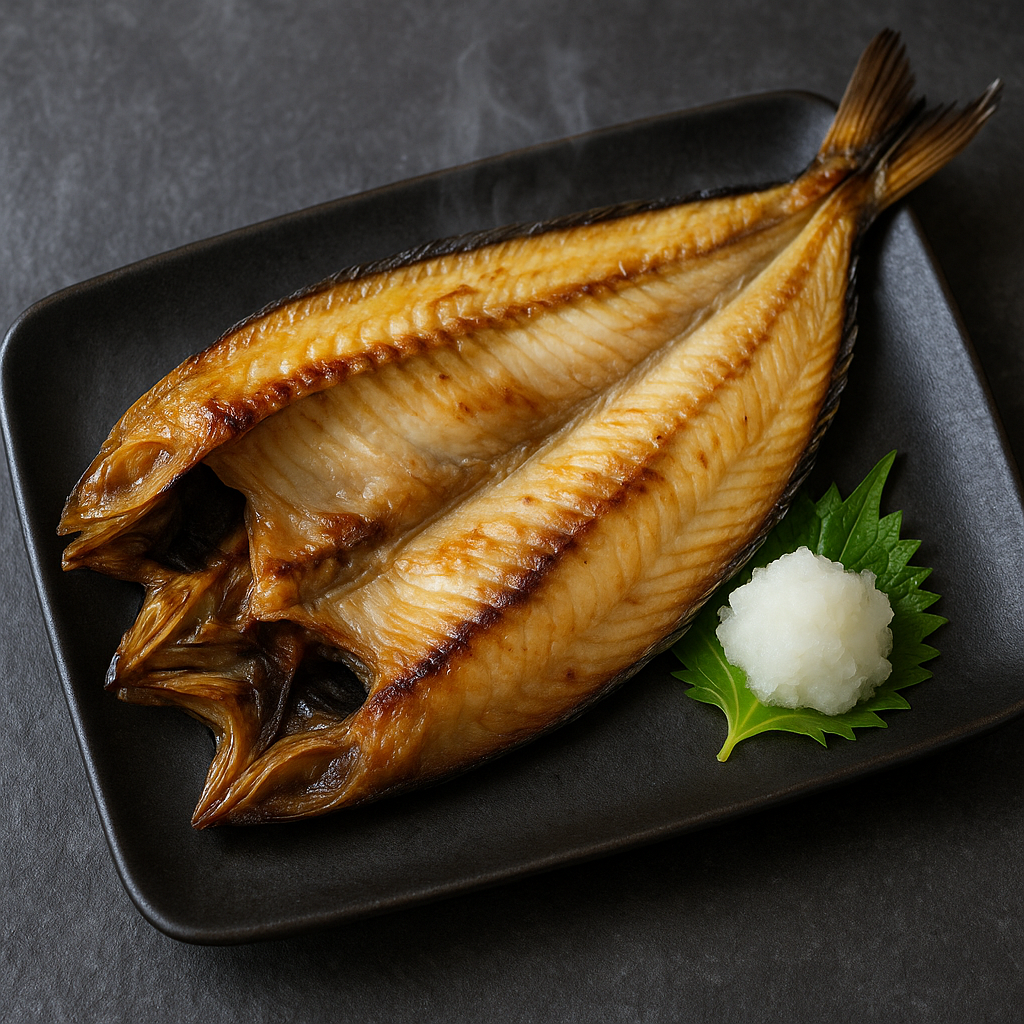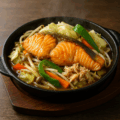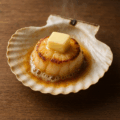ホッケの干物(ホッケの開き)の特徴
北海道を代表する干物
ホッケの干物(ホッケの開き)は、北海道を代表する魚料理のひとつで、新鮮なホッケを開いて塩を振り、干して旨味を凝縮させたものです。脂の乗った肉厚な身と香ばしさが特徴です。
焼いて楽しむ定番料理
干したことで旨味が増したホッケを直火で焼くと、皮はパリッと、身はふっくらと仕上がります。居酒屋や家庭の食卓で定番の一品です。
保存性と旨味の両立
干すことで保存性が高まり、同時に余分な水分が抜けることでホッケ特有の旨味が凝縮されます。
ホッケの干物(ホッケの開き)のレシピ
材料(2人分)
- ホッケの干物(開き済み) … 1枚
作り方
- ホッケの干物を軽く水で洗い、キッチンペーパーで水気を拭き取る。
- グリルまたは魚焼き器を熱し、中火で皮目から焼く。
- 片面に焼き色がついたら裏返し、両面をこんがり焼く。
- 焼き上がったら皿に盛り、大根おろしやレモンを添えて完成。
シェフのワンポイントアドバイス
焼きすぎると身が固くなるため、火加減を中火に保つのがコツです。 グリルではなくフライパンで焼く場合は、クッキングシートを敷くと皮がくっつきにくく、きれいに焼けます。
ホッケの干物(ホッケの開き)の栄養価(1人分の目安)
- エネルギー:約250〜300 kcal
- たんぱく質:25〜30 g
- 脂質:15〜20 g(脂が乗ったホッケの場合)
- 炭水化物:0〜1 g
- ビタミンD・B群(魚由来)
- EPA・DHA(魚由来)
高たんぱくで良質な脂質を含み、カルシウムやビタミンDも摂れる健康的な魚料理です。
ホッケの干物(ホッケの開き)の歴史
漁師町の保存食
ホッケの干物は、北海道の漁師町で鮮度の落ちやすいホッケを保存するために作られたのが始まりです。
戦後の食糧難時代によく配給された干物だったのですが、当時は鮮度と流通の問題から苦手意識を持つ人が多くいます。
現在は加工技術と流通技術が改善された為、若者からお年寄りまで幅広く喜ばれる干物となりました。
食卓への普及
干物として保存性が高まったことで家庭料理に広がり、焼き魚の定番として親しまれるようになりました。
居酒屋文化との結びつき
現在では全国の居酒屋メニューとして定番化し、北海道を代表する焼き魚料理として観光客にも人気です。
English Version
Features of Dried Atka Mackerel (Hokke no Himono)
A Representative Dried Fish of Hokkaido
Dried Atka mackerel, known as “Hokke no Himono,” is one of Hokkaido’s signature fish dishes. Fresh hokke is split open, salted, and dried to concentrate its umami flavor. It is known for its fatty, meaty texture and savory aroma.
A Classic Grilled Dish
Once dried, the flavor of hokke becomes richer. When grilled over direct heat, the skin turns crispy while the flesh remains tender and juicy. It is a staple dish both at home and in izakaya pubs.
Balancing Preservation and Flavor
The drying process not only improves preservation but also removes excess moisture, concentrating the natural umami of hokke.
Recipe
Ingredients (for 2 servings)
- Dried Atka mackerel (split-open) … 1 piece
Instructions
- Rinse the dried hokke lightly under water and pat dry with paper towels.
- Preheat a grill or fish broiler and place the fish skin-side down over medium heat.
- Grill until golden brown on one side, then flip and cook the other side until evenly browned.
- Serve with grated daikon radish and lemon on the side.
Chef’s Tip
Overcooking will make the fish tough, so keep the heat at medium for best results. If using a frying pan instead of a grill, place a sheet of cooking paper under the fish to prevent the skin from sticking and ensure an even finish.
Nutritional Value (per serving, approx.)
- Calories: 250–300 kcal
- Protein: 25–30 g
- Fat: 15–20 g (if the fish is fatty)
- Carbohydrates: 0–1 g
- Vitamin D & B group (from fish)
- EPA & DHA (from fish)
A high-protein, nutrient-rich fish dish that also provides calcium and vitamin D, making it both healthy and satisfying.
Historical Background
A Fishermen’s Preserved Food
Dried hokke originated in Hokkaido’s fishing villages as a way to preserve this highly perishable fish. By drying, fishermen could store it for longer periods.
Post-War Food Shortage
During Japan’s post-war food shortages, dried fish such as hokke were often distributed. However, due to issues of freshness and distribution at that time, some people developed an aversion to it.
Modern Popularity
With improvements in processing and distribution technology, dried hokke has become widely appreciated by both young and old. It is now a beloved staple dish across Japan.
From Home Kitchens to Izakaya Pubs
As a preserved food, it spread to households as an everyday dish. Today, it is also a classic item on izakaya menus nationwide and remains one of Hokkaido’s most popular grilled fish dishes for locals and tourists alike.



何でも質問してください!